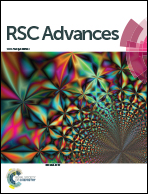Quantitative structure–activity relationships and design of thymine-like inhibitors of thymidine monophosphate kinase of Mycobacterium tuberculosis with favourable pharmacokinetic profiles
Abstract
We have designed new potent inhibitors of thymidine monophosphate kinase of Mycobacterium tuberculosis (TMPKmt) using structure-based molecular design. Three-dimensional (3D) models of TMPKmt–inhibitor complexes were prepared by in situ modification of the crystal structure of TMPKmt co-crystallized with the natural substrate deoxythymidine monophosphate (dTMP) (PDB entry code: 1G3U) and a training set of 20 thymine derivatives bearing an aliphatic or aromatic group attached through a spacer (THMDs) with known inhibitory potencies. A QSAR model was elaborated for the training set THMDs and a linear correlation was established between the computed free energies of THMD binding and observed enzyme inhibition constants (Kexpi). Validation of this QSAR model was performed with 3D-QSAR pharmacophore generation (PH4). Structural information derived from the 3D model and breakdown of computed TMPKmt–THMDs interaction energies up to individual active site residue contributions helped us to design new more potent TMPKmt inhibitors. We obtained a reasonable agreement between the free energies of TMPKmt–THMDs complexation (ΔΔGcom) and Kexpi values, which explained approximately 93% of the TMPKmt inhibition data (pKi = −0.1422 ΔΔGcom + 4.9199, R2 = 0.93). Similar agreement was established for the PH4 pharmacophore model (pKexpi = 1.0016 × pKprei + 0.0077, R2 = 0.95). Comparative analysis of the active site residue contributions directed substitutions to various positions of the naphtholactam or naphthosultam moeties and suggested their replacement with phthalimido or isoindolinone or indanone rings, which led to a predicted increase of the inhibitory potency. The predicted Kprei for the best inhibitor candidate reached the picomolar range for aliphatic acyclic nucleoside analogs and for benzyl pyrimidine-like analogs. This computational approach, which combines molecular modelling, pharmacophore generation and analysis of TMPKmt–THMDs interaction energies resulted in a set of proposed TMPKmt inhibitors. It can thus direct medicinal chemists in their search for new antituberculotic agents.


 Please wait while we load your content...
Please wait while we load your content...